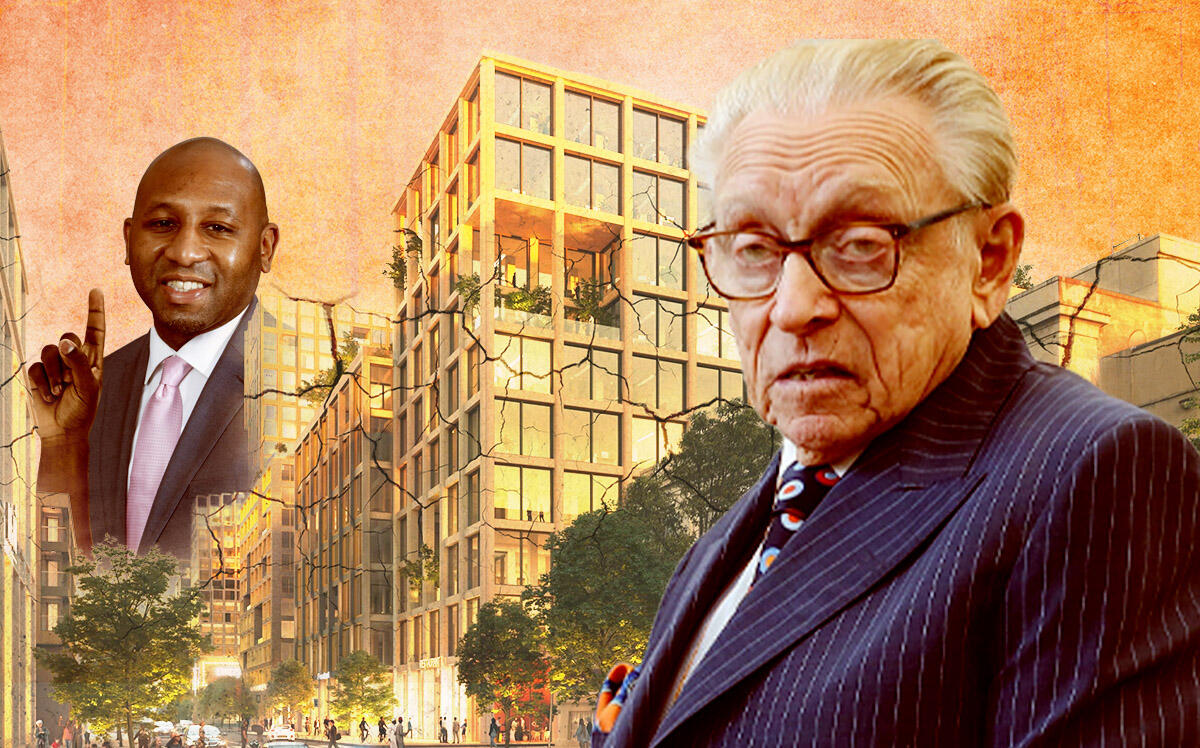 Backers of big Queens megaprojects say city needs the jobs, homes
Backers of big Queens megaprojects say city needs the jobs, homes
Trending
Queens boro prez turns on industry, rejects Silverstein’s $2B project
Astoria megadevelopment facing pushback from community

Real estate thought it had an ally in Queens Borough President Donovan Richards.
Maybe not.
Richards on Thursday night recommended against allowing a $2 billion Queens megaproject by Silverstein Properties, BedRock Real Estate Partners and Kaufman Astoria Studios. The thumbs-down on Innovation QNS comes on the heels of a 917-unit, half-affordable Harlem proposal being killed by the local Council member.
In a lengthy statement detailing his reasons for disapproval, Richards highlighted affordability and neighborhood character.
“New York City residents continue to experience a multitude of intersecting crises: housing affordability, food insecurity, evictions, and stagnating wages for the lowest earners,” he wrote. “Blindly building more market-rate housing will not fix these long-standing, systemic issues.”
The industry supported Richards’ 2020 campaign for borough president, during which he portrayed himself as pro-development and openly courted donations from real estate, which his opponent had sworn off. That same year, as a City Council member, he backed the controversial Industry City rezoning.
But in the most significant real estate issue to come before him, Richards took what has become the standard position in New York City politics, calling for far more affordability than the city’s mandatory inclusionary housing law requires, along with shorter buildings, free city infrastructure and more.
On their own, Richards wrote, the amenities of Innovation QNS would be tremendous additions to Astoria: 100,000 square feet of community space, 711 affordable units and recreational space.
But his advisory opinion declared them small potatoes compared with the project’s 2,100 market-rate apartments and tall structures.
Richards recommended the developers:
- Make 50 percent of the residential floor area permanently affordable (twice what they proposed)
- Reduce the project’s heights, particularly along 35th Avenue
- Make local infrastructure and transit improvements
- Offer discounted rents to nonprofits and small businesses, and make up to half of the commercial spaces no larger than 5,000 square feet
- Instead of building a new school and library, donate to existing schools, scholarship programs and libraries in the area
- Establish a small business grant fund
- Relocate tenants and report progress to him and local Council member Julie Won
- Provide quarterly updates to a community advisory board
Developers seeking rezonings typically leave room for compromise in their proposals, which allows local elected officials to take credit for an eventual deal that they can sell to their constituents. The mandatory inclusionary housing law, which requires 25 percent or 30 percent of residential space to be income-restricted, was supposed to create a standard for affordability but has instead set a new starting point for negotiations.
Innovation QNS has piqued excitement and anxiety in its corner of Queens since the developers first started discussing it with the community in 2018. The five-block project is one of the largest and most ambitious in borough history. Now that Richards has weighed in, the City Planning Commission will vote whether to proceed with the application.
The project would bring around 12 buildings and two acres of open space to an area of Astoria that is mostly parking lots, auto repair shops and car dealerships. Its affordable units would be priced for households earning an average of 60 percent of the area median income. It would add a grocery store, multiplex movie theater, senior housing, health facilities and possibly a school for 600 students.
The retail component is 200,000 square feet, while “creative” industries and small businesses would get 250,000 square feet of office space.
The fate of Innovation QNS rests with Won, the district’s first-term Council representative, as the full Council almost always votes with the local member on rezonings. Won recently released a set of guidelines for developers hoping to upzone swaths of her district, and told City Limits she thinks Innovation QNS has largely failed to meet her prerequisites.
“They have already failed community engagement and affordability,” Won said. “I don’t know if it’s too late.”
“Fuck you, no”
The opinions of the community board — which also opposed the project — and borough president matter because they essentially set a bar for the Council member. Richards reached his decision after 60 days of deliberation, including town halls and public comment sessions.
Such meetings are rarely cordial, but even by that standard, the borough president’s online public hearing in late June was a food fight.
As the developers’ representatives outlined the project, one resident who had been left unmuted blurted out, “No, no. Just looking at the map, the outlines. No. Fuck you, no.”
Read more
 Backers of big Queens megaprojects say city needs the jobs, homes
Backers of big Queens megaprojects say city needs the jobs, homes
 Council members call for override on Industry City rejection
Council members call for override on Industry City rejection
Others called the site’s proposed features, including its two-acre public park, a guise to distract people from the rent increases that they believe development causes (although research has found otherwise).
“Yes, two acres of new parks is appealing. But those of us moving with two eyes open refuse to be hoodwinked by the promise of parks only to be priced out of the neighborhood we love,” said Gil Lopez, co-founder of the Western Queens Community Land Trust, one of the local organizations cited in Won’s development guidelines.
“To the community groups offering harm reduction while partnering with these developers who will do absolutely the most harm: You’re crumb-snatching, nonprofit-industrial-complex profiteers.”
Evie Hantzopoulos, a local community board member and executive director of the Queens Botanical Garden, picked up on the gentrification theme.
“We’re really at a precipice here,” she said. “We can either push back against this rezoning which is inappropriate and does not serve the community’s needs, or we can say ‘This is ok, we don’t care about displacing so many residents … and really changing Astoria from a working-class community to one for higher-income people.’’’
It wasn’t all bad for the developers, who drew some support from residents. Carl Alston, who identified himself as a minority contractor and lifelong resident of Queensbridge Houses, said Innovation QNS “will give us an opportunity to live outside of NYCHA, which is a lot of peoples’ lifelong dream.”
“It’s mind boggling,” Adis Kolenovic said of the opposition. “Right now, that area is a rat-infested, pothole-infested, smelly, loud, truck-infested area. This is currently warehouses — warehouses! So do you want zero affordable apartments, or do you want 540 affordable apartments?”
Living and learning
Rezoning battles call to mind Mark Twain’s truism that history doesn’t repeat itself, but it often rhymes. In lower-income neighborhoods, development proposals tend to stoke fears of gentrification and displacement. In wealthy areas, opponents say they will ruin the character and be out-of-context.
Innovation QNS isn’t Silverstein or BedRock’s first rodeo, but it’s a massive push even for experienced developers. Their spokesperson said they have taken community pushback into account and continue to try to incorporate local input into the development.
One of the local community board’s main justifications for voting against the project was that its most affordable apartments, which would be set aside for people earning 40 percent of the area median income, were still too expensive. The developers agreed to make it 30 percent, which means rents of less than $1,000 a month.
They told The Real Deal they are in talks with the Adams administration about further increasing affordability, which typically involves subsidies or tax breaks.




